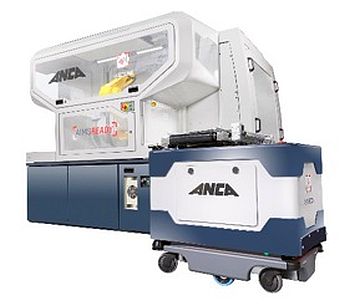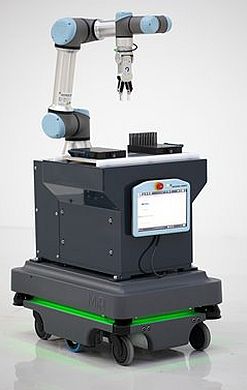AIMS AutoFetch: Safe, Efficient, Automated Way to Transfer Stuff in Your Shop
ANCA recently introduced its Integrated Manufacturing System -- AIMS for short.
AIMS is an ecosystem of individual modules -- or building blocks -- which could be configured to build a tailored automated tool manufacturing system. Modularity and flexibility mean that it caters to both small and large enterprise type manufacturers.

The system could be designed to be very simple, using a trolley for manual pallet and tool transfer with basic ERP connectivity. It could also be a complex, fully autonomous production solution which requires minimal human intervention.
One of the most noticeable components of a fully automated AIMS cell is AutoFetch -- the AMR robot responsible for transferring pallets between the setting station called AutoSet, to the tool grinder. It also automatically transfers single tools for spot check measurements outside of the grinder.As you can imagine, there's a lot of traffic and the AutoFetch can get very busy.
An AIMS cell is typically configured within a footprint of the existing factory with adjoining areas where standard, manual operations are taking place. This is a great flexibility feature but also raises many questions about how autonomous operation can function alongside the traditional production plant with frequent foot traffic.
There's no need to fence off the AIMS area thanks to unique technology used with the AutoFetch robot.
There are generally two types of automatic vehicles used on the factory floor -- AGV and AMR. AutoFetch is an AMR (Autonomous Mobile Robot) which is different than an AGV (Automatic Guided Vehicle). The main difference is the way both units navigate their way around the factory. An AGV always follows a predetermined route which is defined by using various guiding aids like strips embedded in the floor, or reflectors fitted to the walls around the route.
The AMR on the other hand, travels from one location to another using its array of sensors and initially scanned map of the area. It doesn't require any additional infrastructure to transfer material from A to B. You just scan and map the relevant area during AutoFetch setup, mark the load and unload positions and then the robot, using sophisticated algorithms, will find the optimal way from one point to the other.
Safety Implications
The good news is the AutoFetch AMR is designed to safely operate in a factory environment where people are present.

The AMR moves from one station to another using an optimized route, and it constantly scans the immediate area for unexpected objects. When an object is detected, the AutoFetch will stop and navigate around it. An array of sensors -- laser scanners, 3D cameras and proximity sensors -- are used for this purpose.
For extra security, an AMR prohibited area could be defined on the map to exclude autonomous traffic altogether. In addition, the AutoFetch could be programmed to reduce speed in certain areas and warn nearby staff with audio warnings such as beeper, horns, or pre-recorded spoken messages.
72% of manufacturers report accidents related to using traditional means of material transport like pallet jacks, trolleys or forklifts. The use of AMR's contributes to increased safety in the factory and reduced accidents due to the elimination of human factors like fatigue, lack of focus or awareness.
Want more information? Click below.
Rate this article
View our terms of use and privacy policy